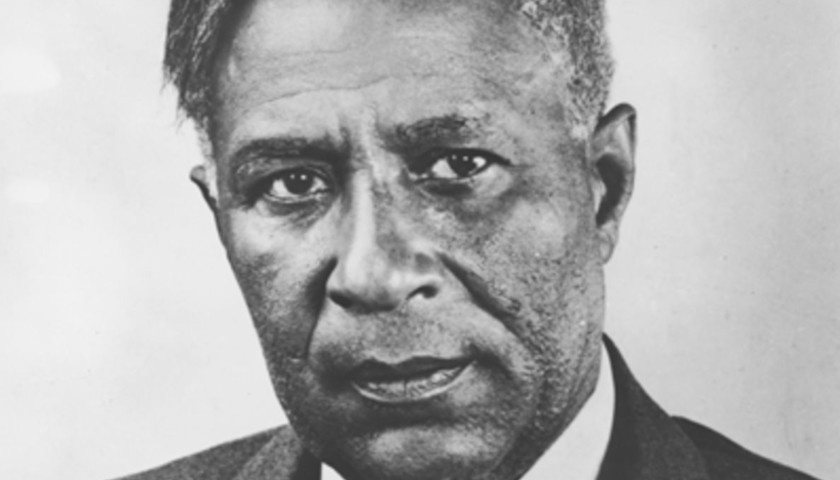Garrett A. Morgan was born on March 4, 1877 in Claysville on the outskirts of Paris, Kentucky to two former slaves. He was one of eleven children and his family was forced to live in a segregated portion of the city, so Morgan left for Cincinnati, Ohio at the age of 14 in search of better opportunities.
He picked up work as a handyman and hired a tutor to continue his education having received just six years of formal education while in Kentucky. In June 1895, he moved to Cleveland, Ohio, where he would spend the rest of his life. He started working in the textile industry as a sewing-machine adjuster for various clothing manufacturers and quickly picked up the skills of the trade.
According to Case Western Reserve University’s Encyclopedia of Cleveland History, Morgan established his own shop for selling and repairing sewing machines in 1907. Then in 1909 he opened up his own tailoring business with 32 employees and manufactured suits, dresses, and coats.
Morgan grew frustrated with sewing wool fabric, since the “machines of the day generated a lot of friction and heat when they were used on wool,” and as a result the fabric was “often scorched in the process,” according to volume four of Inventors and Inventions.
So Morgan decided to develop a lubricant for sewing-machine needles. One day while he was working on the product, his wife, Mary Hasek, whom he had married in 1908, called her husband to dinner. Morgan wiped his hands off on a “cloth made of wiry pony hair” and sat down for dinner. But when he returned to his work, he noticed that the frizzy pony hair had straightened out.
Intrigued by the development, he tested the lubricant on a neighbor’s Airedale dog. It worked so well as a straightener that the owner could no longer recognize his pet. Morgan then tried it on his own hair and found that the product was successful on humans as well. So he began selling a hair-straightening cream called the G.A. Morgan Hair Refiner Cream, which turned into an entire line of hair products that became the G.A. Morgan Hair Refining Company in 1913.
Morgan was simultaneously working on a “breathing device” that would protect its wearer from smoke and ammonia. His device, popularly called the safety hood, was the precursor to the modern day gas mask. He received a patent for his “useful improvements in breathing devices” in 1914.

“The objects of the invention are to provide means whereby a fireman having his head enclosed in a hood with which a hanging air tube communicates will be able to supply himself at will with fresh air from near the floor or other suitable place and at the same time forcibly remove smoke or injurious gases from the air tube,” Morgan wrote in his patent application.
His device was popularized when Morgan and a few volunteers used the safety hood at the request of police officers to rescue workers trapped under Lake Erie during the 1916 Waterworks tunnel disasters. He established the National Safety Device Company and sold his breathing device to the U.S. Navy for use in World War I and fire departments throughout the country.
Some people, however, canceled their orders after discovering Morgan’s race and Morgan was frequently written out of stories about the 1916 rescue operation, according to the book 100 Greatest African Americans.
His most popular invention was still to come. Morgan was an enthusiast of early automobiles, and observed a need for better traffic signals on busy city streets. Cars often collided with horses and buggies, and Morgan himself witnessed a serious accident at an intersection. So he came up with a three-way traffic signal, which was revolutionary because it used a third, cautionary signal between “stop” and “go,” the Encyclopedia of Cleveland History explains.

He received a patent for the device in 1923 and sold it that same year to General Electric for $40,000.
Morgan was also heavily involved in politics and the fight for racial equality in the north. In 1920, he founded and published a newspaper for African Americans known as the Cleveland Call. He helped found the Cleveland Association of Colored Men, and in 1923 bought a farm to build the Wakeman Country Club for African Americans.
He established one of the first black fraternities at Case Western Reserve University, according to the National Inventors Hall of Fame, to which Morgan was inducted in 2005. He made an unsuccessful bid for Cleveland City Council in 1931.
Morgan was diagnosed with glaucoma in 1943, but lived for another 20 years until his death at the age of 86 in July, 1963. A month after his death, Morgan was honored as a pioneering citizen at the Emancipation Centennial Celebration.
An elementary school in Chicago was named in his honor in 1972, and his birthplace of Claysville was renamed Garrett Morgan Place in 1974.
– – –
Anthony Gockowski is managing editor of Battleground State News, The Ohio Star, and The Minnesota Sun. Follow Anthony on Twitter. Email tips to [email protected].





